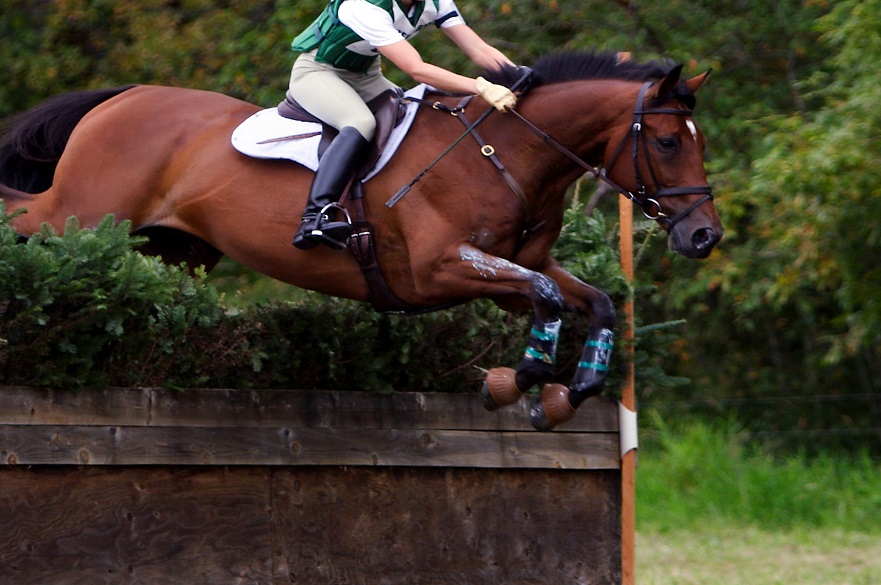Expert blog: Horse falls in eventing – a brief history of one of the most dangerous equine sports
By Dr Heather Cameron-Whytock, an expert in equine sport risk in the School of Animal, Rural and Environmental Sciences.
Published on 19 October 2022
Categories: Press office; Research; School of Animal, Rural and Environmental Sciences;

Equestrian eventing is sometimes known as the ‘Equestrian Triathlon’. Luckily, horses aren’t required to swim, but the sport is composed of three distinct phases. The cross-country phase – which involves galloping across country, over logs, ditches, water and other obstacles composed of ‘natural’ materials – poses the biggest risk of injury and fatality to horse and rider, due to the occurrence of horse falls.
Horse falls typically happen due to the horse coming into contact with one of the cross-country obstacles whilst attempting to jump over it. If a horse hits one of these solid obstacles at speed then rapid deceleration occurs, sometimes causing the horse to rotate in a somersault motion over the fence and land on its back – and potentially on top of the rider. It is no surprise then that these incidents carry substantial risk of serious injury to both the horse and the rider, and in the worst cases even death.
In the past five years alone, there have been 13 rider and ten horse deaths worldwide as a result of horse falls at cross-country fences.
Eventing sport was originally created to test the cavalry’s fitness and suitability, with the first recorded eventing competition held in France, 1902. Since then, eventing has become a long-standing Olympic sport, being included in the Games since 1912. In fact, equestrian sport distinctly contributes to GB Olympic sport success, sitting 9th in the medal table for number of medals won for GB in the summer Olympics. Indeed, eventing specifically is the largest contributor to Equestrian Olympic medals for GB, asserting its dominance as a key player in equine sport.
Despite its competitive successes, eventing has a tumultuous history of horse and rider injury and fatality. The eventing season during the year 1999 is remembered as one of the worst of the sport’s time, with five rider fatalities in the UK alone, four of which were caused by horse falls where the horse somersaulted over a cross-country jump. Since then, a variety of changes have been made to the sport in the pursuit of reducing horse falls.
One of the most notable changes has been the inclusion of fences that are designed to collapse if the horse hits the fence hard. The intention of this design is that when a horse fall is about to occur, the fence collapses to the floor which frees the horse’s legs. In some circumstances this allows the horse to ‘catch’ itself and prevent the fall occurring altogether, and in other cases it prevents the dangerous somersault motion of the fall. Unfortunately, there are currently no published scientific studies that have investigated whether collapsible fences reduce the risk of horse falls, and in fact it has been shown that these fences are associated with a higher risk of horse falls.
The incidence of somersault horse falls has steadily declined for UK national level eventing competitions, from 0.2% in the 2002-2003 season to 0.05% for the 2020 eventing season. In addition, the incidence of serious or fatal rider injury has declined at UK national level competition from 0.27% during the 2002-2003 season to 0.07% during the 2020 season.
At international level competition however, a decline in risk is less apparent, indicative of the increased physical challenge at international level competitions.
Despite the proportion of somersault falls and serious/fatal rider injuries declining at national level competitions over the last two decades, fatalities are still occurring in the sport, highlighting the need for continued risk management. In addition, horse injury and fatality rates are not reported in official documentation by either the national or world eventing governing bodies, resulting in a lack of knowledge on equine injury and fatality rates within the sport.
Several studies have investigated risk factors for horse falls in eventing during the last 20 years. Recently, large-scale studies have been published for the first time in this field of research, which encompass data from extensive periods of time. One such study published in 2021 reported that higher event levels, longer course distances, male riders and less experienced horses and riders all carried higher risk of a horse fall.
A later study of comparable size and scope, published in 2022, investigated risk factors associated with fence and course characteristics. This study reported that fences with an approach downhill, landing into water, frangible (collapsible) fences and ‘corner’ fences (fences shaped in a triangular/corner shape, which are jumped on an angle) are all associated with higher risk of falls. These studies highlight several areas of interest for risk management strategy.
The availability of large-scale and up-to-date research that has highlighted risk factors for horse falls is crucial for the sport of eventing. Future research should begin to adopt a more multi-disciplinary approach as whilst retrospective data analyses are valuable, they may only tell part of the story. Fence design, horse/rider behaviour and technique, and rider psychology are all areas that need more research in this field.
The next steps towards a safer sport, however, rely on the commitment of governing bodies to not only engage with the findings of science but also to act on them.